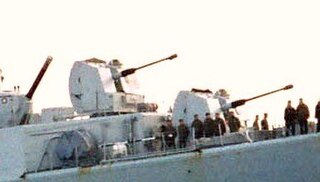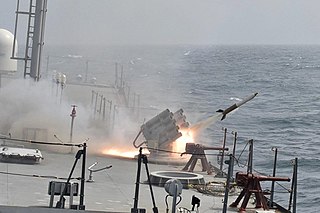
The RUR-5 ASROC is an all-weather, all sea-conditions anti-submarine missile system. Developed by the United States Navy in the 1950s, it was deployed in the 1960s, updated in the 1990s, and eventually installed on over 200 USN surface ships, specifically cruisers, destroyers, and frigates. The ASROC has been deployed on scores of warships of many other navies, including Canada, Germany, Italy, Japan, Taiwan, Greece, Pakistan and others.

A frigate is a type of warship. In different eras, the roles and capabilities of ships classified as frigates have varied.

A corvette is a small warship. It is traditionally the smallest class of vessel considered to be a proper warship. The warship class above the corvette is that of the frigate, while the class below was historically that of the sloop-of-war.

A warship or combatant ship is a ship that is used for naval warfare. Usually they belong to the navy branch of the armed forces of a nation, though they have also been operated by individuals, cooperatives and corporations. As well as being armed, warships are designed to withstand damage and are typically faster and more maneuverable than merchant ships. Unlike a merchant ship, which carries cargo, a warship typically carries only weapons, ammunition and supplies for its crew.

The Flower-class corvette was a British class of 294 corvettes used during World War II by the Allied navies particularly as anti-submarine convoy escorts in the Battle of the Atlantic. Royal Navy ships of this class were named after flowers.

HMS Hurst Castle (K416) was one of 44 Castle-class corvettes built for the Royal Navy during World War II. Completed in June 1944, she began escorting convoys in August and was sunk by a German U-boat the following month.

A stealth ship is a ship that employs stealth technology construction techniques in an effort to make it harder to detect by one or more of radar, visual, sonar, and infrared methods.

The Udaloy class, Soviet designation Project 1155 Fregat and Russian designation Project 11551 Fregat-M, are series of anti-submarine guided-missile destroyers built for the Soviet Navy, seven of which are currently in service with the Russian Navy. Twelve ships were built between 1980 and 1990, while the thirteenth ship built to a modified design, known as Udaloy II class, followed in 1999. They complement the Sovremenny-class destroyers in anti-aircraft and anti-surface warfare operations. The codename Udaloy comes from a Russian adjective удалой, meaning daring or bold.

The RBU-6000Smerch-2 is a 213 mm caliber Soviet anti-submarine rocket launcher. The system entered service in 1960–1961 and is fitted to a wide range of Russian surface vessels. It consists of a horseshoe-shaped arrangement of twelve launch barrels, that are remotely directed by the Burya fire control system. It fires RGB-60 rockets, which carry unguided depth charges. The rockets are normally fired in salvos of 1, 2, 4, 8 or 12 rounds. Reloading is automatic, with individual rounds being fed into the launcher by the 60UP loading system from a below-deck magazine. Typical magazine capacity is either 72 or 96 rounds per launcher. It can also be used for shore bombardment.

The People's Liberation Army Navy Surface Force is the surface warfare branch of China's People's Liberation Army Navy (PLAN), consisting of all surface vessels in operational service with the PLAN. The PLAN Surface Force operates 661 ships organized into three fleets: the North Sea Fleet, the East Sea Fleet and the South Sea Fleet.
MILGEM project (Turkish: Milli Gemi Projesi; English: National Ship Project) is a national warship program of the Republic of Turkey. Managed by the Turkish Navy, the project aims at developing multipurpose corvettes, frigates and destroyers that can be deployed in a range of missions, including reconnaissance, surveillance, early warning, anti-submarine warfare, surface-to-surface and surface-to-air warfare, and amphibious operations.

Burak-class corvette, also known as the B-class corvette, is a warship class of the Turkish Navy, all ex-D'Estienne d'Orves-class A69 type aviso corvettes, mainly designed for coastal anti-submarine defense & ocean escort missions. Their robust design & economical propulsion system allows them to be used for distant overseas operations.

The Parchim-class corvette, Soviet designation Project 1331M, was developed for the East German Navy in the late 1970s, and built by the Wolgast Peene-Werft. The ships were designed for coastal anti-submarine warfare. In case of an all-out NATO-Warsaw Pact war in Europe their prime targets would have been the small U-206 coastal submarines of the West German navy. The first ship, Wismar, was launched on 9 April 1981 in Rostock, and subsequently another 15 ships were built until 1986. To make production more economical, the Soviet Union agreed to purchase another 12 ships from Wolgaster Peenewerft built between 1986 and 1990, thereby effectively subsidising the East German shipbuilding industry.

The Kamorta-class corvettes or Project 28 are a class of anti-submarine warfare corvettes currently in service with the Indian Navy. Built at Garden Reach Shipbuilders & Engineers (GRSE), Kolkata, they are the first anti-submarine warfare stealth corvettes to be built in India. Project 28 was approved in 2003, with construction of the lead ship, INS Kamorta commencing on 12 August 2005. All of the four corvettes, INS Kamorta, INS Kadmatt, INS Kiltan and INS Kavaratti were commissioned in 2014, 2016, 2017 and 2020 respectively.

The Poti class was the NATO reporting name for a group of anti-submarine warfare (ASW) corvettes built for the Soviet Navy. The Soviet designation was Project 204 small anti-submarine ships. These ships were the first Soviet warships powered by gas turbine engines; two propellers were mounted in tunnels to give a very shallow draught. A twin 57 mm (2 in) gun mounting provided self-defence. Three ships of the class were exported to Romania and six to Bulgaria during the Cold War. By 2008, all ships of the class were no longer extant.

The 76mm/L62 Allargato is a single barrel, medium caliber, dual purpose automatic naval cannon designed and produced in the 1960s by the Italian defence firm of OTO-Melara as the cannon armament for all medium and large warships built for the Italian Navy in that decade. Currently, the gun remains in service with Italy's Cassiopea-class patrol vessels but has otherwise been largely replaced by the Otobreda 76 mm series of cannons.

The Sovremenny class, Soviet designation Project 956 Sarych (buzzard), is a class of anti-ship and anti-aircraft guided-missile destroyers of the Soviet and later Russian Navy. The ships are named after qualities, with "Sovremenny" translating as "modern" or "contemporary". Most of the ships have been retired from active service and one converted into a museum ship in 2018; as of 2021 three remain in commission with the Russian Navy with several in overhaul. Four modified ships were delivered to the People's Liberation Army Navy, and remain in service.

INS Kadmatt (P29) is the second of four anti-submarine warfare corvettes built for the Indian Navy by the Garden Reach Shipbuilders and Engineers, of Kolkata, under Project 28. She was inducted into the Eastern Naval Command of the Indian Navy.

Kavach is an anti-missile naval decoy system to distract radar-guided missiles from their targets and act as a system for self-defence. It was designed and developed by the Ordnance Factory Board for the Indian Navy.

The RBU-1200 is a anti-submarine rocket launcher. The weapon system is remotely similar to the British Hedgehog anti submarine mortar launcher from the Second World War.





















